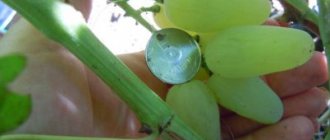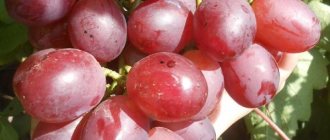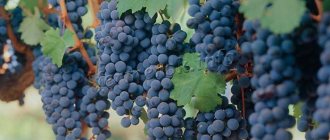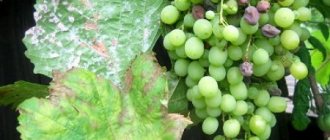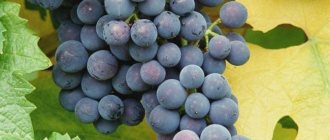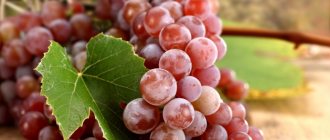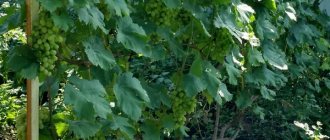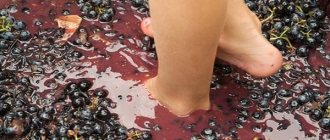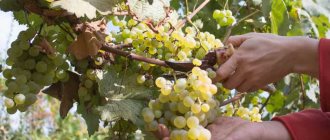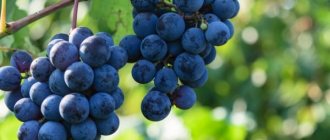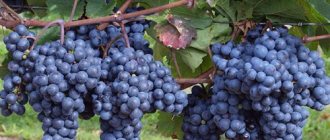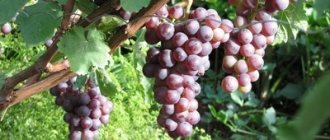Viticulture, as a part of agriculture, is an ancient craft. More than a thousand years ago, the first cultivated grapes were grown. Of course, then the plant was completely different in taste and external qualities. Today there are a large number of varieties, so choosing is difficult. Especially if there is no description of the qualities of the grapes, the main characteristics are not indicated.
We present to our readers the Libya grapes, grown quite recently, but which have managed to win the hearts of gardeners. The author of the variety is Vitaly Vladimirovich Zagorulko, who lives in Zaporozhye. He has been involved in selection work for a long time. Russian winegrowers are familiar with its hybrid grape varieties. Many people grow Bazhena, Veles, Zabava, Sofia and others. The Libya grape variety (see photo) was obtained from crossing Flamingo and Arcadia and has been included in the register in Ukraine since 2011.
The photo shows a bunch of Libya grapes.
Advantages and disadvantages
Pros:
- Attractive appearance.
- Long shelf life.
- Good transportability.
- Harvest stability.
- A large number of berries.
- Precocity.
- Bisexuality.
- Excellent taste characteristics.
- Possibility of growing both in a private garden and on an industrial scale.
Minuses:
- Uneven ripening.
- Susceptibility to mildew and oidium.
- Weak winter hardiness.
- Requires rationing.
- Attracts wasps and birds.
Origin
Parents of “Livia” are “Arcadia” and “Flamingo”
“Libya” is the fruit of the work of the famous Ukrainian breeder Vitaly Vladimirovich Zagorulko, who is the author of such varieties as “Veles”, “Bazhena”, “Zabava”, “Sofia”, etc. To breed “Libya” he crossed “Arcadia” and “flamingo” , which gave the “daughter” an attractive appearance, early ripeness and marketability. The variety was included in the state register of Ukraine in 2011, Russia - in 2014.
Characteristics
These grapes are classified as table grapes. Its bushes have both female and male flowers. Therefore, it does not “pea” and can be used as a pollinator for other varieties of crops.
Ripening period
Libya berries ripen in 90-115 days. However, this happens unevenly; the difference in the color of the fruit is especially noticeable in conditions where the vineyard does not have enough sun.
Frost resistance
Libya's resistance to cold is average. The variety is able to withstand frosts down to -21ºС, so when grown in regions with harsh winters, the vines require shelter.
Bush
The bushes are tall, vigorous, have a powerful trunk and strong shoots. Mature plants are distinguished by a large number of large dark green leaves. Moreover, on young vines the crown is initially soft green. The first leaf on it is formed with smooth edges, the subsequent ones are cut into five blades.
The root system of the plant is well developed and is able to quickly recover from damage. Cuttings and seedlings take root without problems. The first harvest can be obtained 3 years after planting. For bushes, short pruning with the formation of 4 sleeves is preferable.
bunches
The brushes of this variety are impressive in size: they can reach a length of 35 cm. At the same time, their average weight is 600-900 g, but with proper care you can get especially large ones - more than 1.5 kg.
Most often they do not have a specific shape, but sometimes they are cylindrical. The berries in the bunch are packed loosely, which ensures good air circulation between them and reduces the risk of diseases.
Berries
One of the key advantages of the variety is its large-fruited size and average berry parameters:
- Length - 2.8 cm.
- Width - 2.5 cm.
- Weight - 8-16 g.
They can be round, ovoid or oval. The color of the fruit varies from yellowish to pink with a purple tint, and it changes during the ripening process.
Reference! The berries have fleshy pinkish, slightly astringent pulp with a high sugar content and subtle notes of nutmeg. A distinctive feature of the variety is its taste, reminiscent of caramel.
Nutritional characteristics:
- Sugar content - up to 25%.
- Acidity - 5-9 g/l.
The skin on the fruit is soft and practically unnoticeable when eaten. There are not many seeds - 2-3 per berry, but they are quite large and are easily separated from the pulp.
Productivity
The plant usually bears fruit in August. One bush produces approximately 25-30 kg of berries, which on an industrial scale equals 170 c/ha. At the same time, the fruits are not prone to shedding, but in hot weather they can bake under the influence of direct sunlight.
Methods for planting new bushes
Grapes of this variety can be propagated by grafting or cuttings. Experienced gardeners can use any method, including grafting. To carry out this procedure you should:
Make sure to cut the seedling correctly so that it is cut with a wedge on both sides.- Cut off the lower part below the first eye.
- After cutting, lower the upper part into paraffin for a few seconds. This is done to ensure resistance to the external environment and moisture conservation.
- Prepare the rootstock. It is part of an adult bush that is planned to be grafted. For this purpose, the old bush is cut off at the root, leaving a stump 10 cm high.
- Make the cut area even and smooth. The split in the middle is made so that the cutting can fit there.
- Use a piece of cloth to tightly connect the area of the chip after placing the cutting in it. To retain moisture, the grafting site is covered with clay.
Inexperienced gardeners are better off choosing the cutting method due to its ease . To plant a finished seedling in the ground you need:
- Select a seedling with two or three buds, without visible damage or signs of disease. In this case, the root system should be healthy, and the cut site should be green.
- Trim the ends of the roots and treat them with a growth stimulator before planting in a permanent place.
- Dig a planting hole four times larger than the seedling. Humus is poured into the prepared hole to the middle, sand and soil are added on top. Humus itself can burn the root system of the seedling.
- Take extra care when planting in the ground. At this point, fragile roots can be easily damaged. Place the seedling so that two buds remain on the surface.
It is better to plant new bushes in spring or autumn. In the first year, stakes are used as support. Starting from the second year of growth of the bush, trellises are used to support the vine.
Features of cultivation
To get a generous grape harvest, you need to choose the right planting site and take care of the bushes.
Soil and planting
In regions with a mild climate, planting can be done in autumn or spring, in areas with cold winters - exclusively in spring before buds appear.
In autumn, the procedure can be carried out immediately after the leaves fall. 4 weeks will be enough for the bushes to adapt and prepare for wintering. In spring, planting can begin when the soil warms up to 12-15ºС, but if there is a chance of frost, it is better to cover the seedlings.
The place for the vineyard should be sunny, so it is better to give preference to the western or southern side of the site. It would be good if there was some kind of support and protection from wind and drafts nearby.
Vintage "Libya" on the arch
Important! “Libya” does not make any special demands on the soil, the main thing is that a large amount of moisture does not accumulate in the substrate. However, grapes produce the best yields on light loamy and sandy loam soil or on black soil.
The wells should be prepared 3-4 weeks before the procedure:
- Dig a hole 80x80x80 cm.
- Place a layer of drainage (expanded clay or crushed stone) at the bottom.
- Pour 12-15 cm of chernozem with the addition of potassium sulfide and superphosphate.
- Add a layer of black soil with fertilizers, and then another bucket of clean black soil.
- Pour out 5 buckets of water.
- Leave a hole for shrinkage.
When it's time to board:
- Form a small mound of substrate in the hole.
- Place the seedling on it and straighten the roots.
- Cover with soil and compact.
- Water generously.
There should be 2 buds protruding above the surface of the earth: one at the level, the other above. A support peg should be installed in the center of the hole for each seedling, which will help the bush to form correctly.
Trimming
A good harvest cannot be obtained without pruning - the berries can only ripen fully on moderately loaded vines, so it is recommended:
- Form no more than 4 sleeves.
- Trim shoots to 2-6 eyes.
- Remove excess ovaries, leaving 1-2 bunches for shoots.
- Do not pick off foliage.
- Do not leave more than 45-50 eyes on one bush.
- Regulate the number of stepchildren - Libya produces too many of them.
Reference! When pruning, it is important to take into account that fruiting is shifted towards the base of the vine.
The procedure should be carried out twice a year:
- In the spring, before sap flow begins, damaged branches must be removed and rationed.
- In the fall, after harvesting, remove shoots that have not had time to ripen.
The short form of pruning can be used only in places with a mild climate; in all other cases, it is important to form the bush so that the branches can be lowered to the ground for shelter for the winter.
Care
To pick sweet and juicy berries, it is important to pay enough attention to the bushes:
- Watering. In the spring, after removing the cover, the first thing you need to do is water the plants, at the rate of 4 liters of water with 500 g of wood ash for each bush. Also, moisture should be added 7 days after flowering and during the formation of ovaries. It is important to stop watering while the berries are being filled. The amount of water can be adjusted according to the condition of the leaves: if they are brown in the heat, then there is too much moisture.
- Feeding . At the beginning of the growing season, it is recommended to apply nitrogen fertilizers, and during the ripening of berries - phosphorus. Additionally, you can use organic matter - barnyard, manure, ash and various minerals, for example, urea, potassium salt and superphosphate.
- Mulching is a mandatory process for Libya. Covering the soil with an additional layer of organic matter will not only retain moisture longer and protect the roots in case of frost, but will also provide the nutrients the plant needs.
Diseases and pests
The most likely threats to Libya include fungal diseases - oidium and mildew. They can be recognized by the appearance of plaque, first on the leaf blades, and then on other parts of the plants.
To prevent infection, a series of preventive treatments should be carried out and agrotechnical recommendations should be followed.
Spraying with sulfur-containing preparations is effective against oidium, and mildew is afraid of Bordeaux mixture. However, there are also complex fungicides that can combat these diseases.
The main pests of “Libya” are wasps and birds, for which the sweet pulp of the fruits of this variety is a real delicacy. To protect against them, you should cover the trellises with a thin cloth or transparent mesh, and for wasps, additionally place traps with sugar or insecticidal honey around the vineyard.
Grapes are also susceptible to attack by spider mites, cicadas, leaf rollers, weevils and thrips. Insecticides such as Actellica and Confidora should be used against them.
Reference! All chemical treatments must be stopped 3-4 weeks before harvesting the berries.
Wintering
Option for covering grapes for the winter
Young plants need shelter for the winter, regardless of temperature , adults - only in cases where there are frosts below -21ºC in the region.
- In the fall, trim the vines, treat them against pests and diseases, and remove them from the trellis.
- Place on boards or slate.
- Cover with agrofibre or burlap.
- Stretch mesh or roofing felt to protect against rodents.
- Place spruce branches on top.
When snow falls, you need to form a snowdrift over the shelter.
Storage
The variety has good shelf life - the berries do not lose their presentation and taste characteristics within a month from the moment of collection. This is achieved thanks to the elastic pulp and durable skin. For the same reasons, fruits easily tolerate transportation.
Regions
“Libya” does not have high frost resistance, but if good shelter is provided, the variety can be grown in regions with cold climates. Due to its early ripening, this grape variety performed well in the Moscow region and central Russia, although it was recommended for cultivation only in the North Caucasus region.
Watering methods
Many experienced gardeners water the bushes twice during the season. The first watering is carried out during the flowering period of the grapes. The second watering occurs during the formation of the ovary. This method is possible when natural precipitation occurs between waterings. If they are absent, you should water the bushes more often.
When watering grapes, care must be taken. Excess moisture can cause the berries to crack, making the crop unsuitable for sale and consumption. In hot weather, you should not limit watering of grapes.
Comparison with analogues
Let’s compare “Libya” with similar varieties.
| Sign | Variety | |||
| Libya | Transfiguration | Sofia | Anniversary of Novocherkassk | |
| Ripening period | 90-115 days | 110 - 115 days | 110 - 115 days | 1150 – 120 days |
| Frost resistance | Up to -21 °C | Up to -23 °C | Up to -21 °C | Up to -23 °C |
| Yield per bush | up to 30 kg | Up to 20 kg | up to 70 kg | Up to 20 kg |
| Bunches | 600-1500 g | 700-3000 g | 800-1200 g | 700 – 3000 g |
| Taste | caramel with nutmeg notes | Sweet with slight sourness | Muscat aftertaste | Harmonious |
| Color | light pink to pinkish purple | Pink | Light pink | Pink with white and yellow shades |
| Disease resistance | average | Average | Average | Above average |
| Shelf life | 1 month | 2 months | 3-5 weeks | 1 month |
| Sugar content | 21-25% | 17 — 19% | 20% | 16,50% |
| Acidity | 5 – 9 g/l | 6 – 7 g/l | There is no information about acidity, but the taste is assessed as low | 6g/l |
The “Livia” variety is excellent for growing in areas unconventional for viticulture , while it has excellent taste characteristics and does not require special knowledge and skills from the gardener. The main thing is to follow the care recommendations, and then large caramel berries will not keep you waiting long.
Description of the variety
Berries can have a variety of shapes: from oval to round. The color of the berries can be different and vary from pink to yellow, sometimes with a purple tint. The berries have thin skin and fleshy, dense pulp. Fruits with a nutmeg aroma, which is not lost during storage of the crop.
The berries have a high sugar content (about 25%). Dense and large brushes have an excellent presentation. To protect against wasps, farmers often use special mosquito net bags. About 105 days pass from the moment the buds open to the start of fruiting. The flowers of the Libya grape variety are bisexual, which contributes to excellent pollination when growing a single bush on the site. Care must be taken when transporting crops.
Photo
Check out photos and reviews about the Libya variety.
Reviews
Libya produces very tasty berries, children simply adore them. But the fact that they ripen at different speeds is a significant drawback, because by the time you wait for the last fruits to turn pink, the first ones will already be overripe. Igor, Moscow region
I brought these grapes from the south in the form of sprouts three years ago, and recently we tried the first berries. Very tasty, you can’t buy these in the store! Irina Davidovna
My wife and I have an entire plantation of Libya; we love this variety for its delicate nutmeg taste and invisible skin. I think this is one of the best early ripening varieties. Vladimir Moiseenko
Reproduction
Rooting of Libya's cuttings is going well. Young bushes begin to bear fruit only after two years, that is, the third after planting. If you do not necessarily need large bushes, then by grafting onto a low-growing rootstock you can grow the bushes a little more compact in size. Propagation by grafting has another undoubted advantage - the ability to use perennial trunk wood for growing, thanks to which yields increase.
The best time for planting young bushes will be early spring and autumn. In the first year of growth, growing shoots must be tied to vertical stakes; then, for these purposes, it will be necessary to use more reliable support, for example, trellises.
